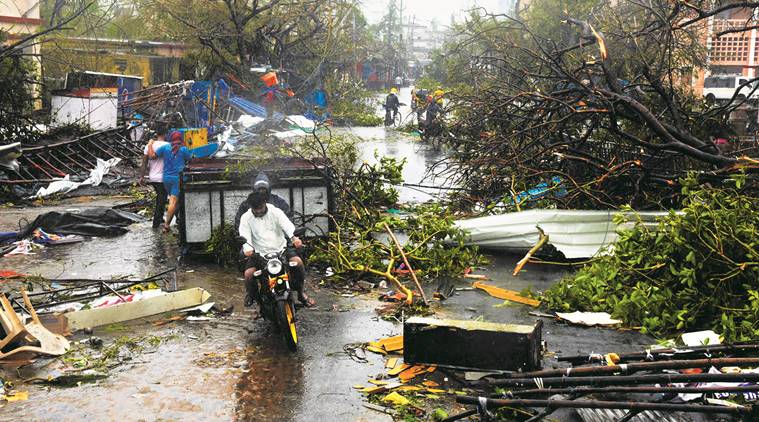
Revisiting Amphan's predecessor, the Super Cyclone of 1999
In Odisha, when a cyclone is predicted, an instant comparison is drawn with the Super Cyclone of 1999. “Is it going to be worse than aneshwata mahabatya (99 super cyclone)?” is often the question asked, to gauge the intensity of the calamity.

In Odisha, when a cyclone is predicted, an instant comparison is drawn with the Super Cyclone of 1999. “Is it going to be worse than aneshwata mahabatya (99 super cyclone)?” is often the question asked, to gauge the intensity of the calamity.
For that was the most devastating of cyclones registered in the collective memory of the people of the state. Raging at a speed of 270-300 kmph, it had wreaked devastation across coastal Odisha killing more than 10,000 people (unofficial figures quote the number at 50,000).
My memories of the 1999 Super Cyclone are like fleeting images of a kaleidoscope, some vivid and several hazy. The Super Cyclone was preceded by another on October 17 which had affected southern Odisha and, people thinking that the worst was over were not well prepared to face the calamity on October 29. In other words, a cyclone was predicted, but no one knew it would be the most menacing people along the bay have seen in years. It was only later that we learned to address the storm as mahabatya or Super Cyclone.
For us children, it meant adventure – rains, storms, and no school.
As predicted, October 29 morning saw heavy rains and whistling winds. People braving the rain hurried to markets to make last-minute purchases before the shops closed. The worst was yet to come. The wind gradually started gaining speed, and the sky turned black. Darkness accompanied by high-speed wind enveloped houses, giving us the feeling of being in the middle of a whirlwind.
Ensconced in our safe homes, we could hear the sound of billboards being ripped off by the wind, flower pots being crushed to the ground, and glass panes of windows getting splintered. Cabin and makeshift shops were uprooted from their foundations and swung away like toys. A gusty gale was vigorously shaking a giant asbestos sheet atop a neighbour’s outhouse. Within a few minutes, it was blown away. The growl of the storm was growing louder as the day progressed.
Related news: As cyclone Amphan makes landfall, heavy rain lashes coastal Odisha
The fun and spirit of adventure had vanished within us when we realized the storm was bigger than we had ever seen. We sat and listened in darkness and silence as it raged with all its fury outside.
The calm came the next morning.
We children were not allowed to venture outside, but saw the devastation wreaked by the cyclone from the terrace. Those were the days when Cuttack was full of cabin shops. Most of them were now shredded and strewn along the road, their contents spilled open. Glass showcases of shops lay open with fresh merchandise floating in the water. The rest were quickly pilfered. Electricity poles and power lines were a jumbled mess (it took around 15 days in our town for power to be restored and months elsewhere).
For our parents, the next concern was to see that we get essential supplies and water for the next few days. Meals were rationed and so was water. Only a few people had bothered to stock up on essentials and cash before the cyclone and lent whatever help they could to neighbours. Only a few houses had generators and after our overhead tank ran out of water, we had to ferry water in buckets from a neighbourhood hand-pump.
We had no communication with the outer world to be able to measure the range of devastation the cyclone had caused. Those were the days when the internet or mobile phones were yet to make it to households. The radio, albeit with interruptions, was our only conduit.
It was only days later that we heard the horrifying stories from low-lying areas – how people ran for their lives when gigantic waves as high as 30 feet chased them and swallowed those who couldn’t keep up; how whole families and villages were levelled by the sea, of bloated dead bodies and cattle populating villages instead of people, and of survival stories of people who clung on to trees till help reached them.
Our house in the village in Jagatsinghpur district (one of the most affected by the cyclone) turned into a virtual shelter home for the cyclone-displaced for months to come (the cyclone shelters of Odisha government were built later). Similar arrangements were seen in village schools and homes of pucca-house owners. When supplies ran out, many had to dig out tubers from their backyard to sustain themselves till relief was airdropped.
Related news: Wind speed, direction, warnings: Cyclone Amphan explained
Those were the days before Naveen Patnaik came to power and cyclone shelters were sprinkled across the state, the Odisha Disaster Rapid Action Force was formed (2001), a solid State Disaster Management Policy was put in place (2005), the weather forecast was updated and even the National Disaster Relief Force (NDRF) was founded.
Odisha ever since has battled numerous cyclones – Phailin, Hudhud, Titli, Bulbul, and most recently Fani; and has re-emerged with resilience.
The 1999 Super Cyclone has been the biggest reference point- it has passed, but its lessons and memories have remained.

